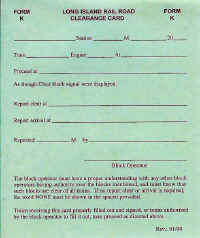|
 Card
used in replacement of block signals in dark/manual block territory. Card
used in replacement of block signals in dark/manual block territory.
Collection: Paul Strubeck
PD controlled all the
Block Limit Stations, BO, MO, PT, SK, WH, ND, SN, BH, AG, and MY
(Montauk) until everything was transferred
to Babylon, PD would issue "K" cards to allow passage by those
BLS's without stopping, but reporting clear of the block station by
radio to PD.
LIRR Training Dept. track maps
dated 01/2000, "Y" and MS were controlled by PD. LIRR Training
Dept.
track maps dated 10/2010, "Y", PD, JJD (MS) and SK (Speonk)
were remoted to Babylon. Also. all the
remaining Block Limit Stations, WH, ND, SN, BH, AG, and MY(Montauk) are
controlled by Babylon. (per the 10/2010 track maps)
|